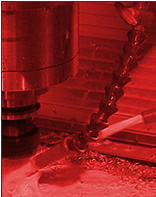
| Services | Literature | Company News | Employment | Request a Quote |
|

 |
||
The abbreviation CNC stands for computer numerical control, and refers specifically to a computer "controller" that reads G-code instructions and drives a machine tool, a powered mechanical device typically used to fabricate components by the selective removal of material. CNC does numerically directed interpolation of a cutting tool in the work envelope of a machine. The operating parameters of the CNC can be altered via software load program. In a production environment, a series of CNC machines may be combined into one station, commonly called a "cell", to progressively machine a part requiring several operations. CNC machines today are controlled directly from files created by CAM software packages, so that a part or assembly can go directly from design to manufacturing without the need of producing a drafted paper drawing of the manufactured component. In a sense, the CNC machines represent a special segment of industrial robot systems, as they are programmable to perform many kinds of machining operations (within their designed physical limits, like other robotic systems). CNC machines can run over night and over weekends without operator intervention. Error detection features have been developed, giving CNC machines the ability to call the operator's mobile phone if it detects that a tool has broken. While the machine is awaiting replacement on the tool, it would run other parts it is already loaded with up to that tool and wait for the operator. The ever changing intelligence of CNC controllers has dramatically increased job shop cell production. Some machines might even make 1000 parts on a weekend with no operator, checking each part with lasers and sensors. |
|||
|
|||
CNC lathes are rapidly replacing the older production lathes (multispindle, etc) due to their ease of setting and operation. They are designed to use modern carbide tooling and fully utilize modern processes. The part may be designed by the Computer-aided manufacturing (CAM) process, the resulting file uploaded to the machine, and once set and trialled the machine will continue to turn out parts under the occasional supervision of an operator. The machine is controlled electronically via a computer menu style interface, the program may be modified and displayed at the machine, along with a simulated view of the process. The setter/operator needs a high level of skill to perform the process, however the knowledge base is broader compared to the older production machines where intimate knowledge of each machine was considered essential. These machines are often set and operated by the same person, where the operator will supervise a small number of machines (cell). The design of a CNC lathe has evolved yet again however the basic principles and parts are still recognisable, the turret holds the tools and indexes them as needed. The machines are often totally enclosed, due in large part to Occupational health and safety (OH&S) issues. |
|||